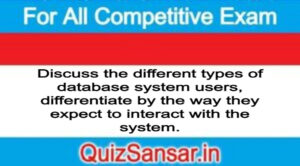
Discuss the different types of database system users, differentiate by the way they expect to interact with the system.
Discuss the different types of database system users, differentiate by the way they expect to interact with the system.
Ans.
Database Users
The basic objective of a database system is to provide an environment for storing data into the database, retrieving from it, and using data to solve the problems. Therefore, there may be different types of users of database. Based on the types of interface the users have with the database, they can be classified into five categories:
(i) Sophisticated users interact with the system without writing programs. Instead, they form their requests in a database query language. Each such query is submitted to a query processor whose function is to take a DML statement and break it down into instructions that the database manager understands.
(ii) Application programmers are computer professionals who interact with the database through data manipulation language (DML) calls which are embedded in a program written in a host computer language, e.g., COBOL, Pascal, PL/I, C, and so on. Through these languages, application programs are written (as discussed in earlier chapters). Since the data manipulation-language syntax is usually markedly different from the host language syntax, DML calls are usually prefaced by a special character so that the appropriate codes are generated. A special processor, known as the DML pre-compiler, converts the DML calls into normal procedure calls in the host language. The resulting program is then run through the host-language compiler, which generates appropriate object codes.
(iii) Specialized users are the computer professionals (or some sophisticated users) who write specialized database applications that do not fit into the traditional data-processing framework. Among these applications are computer-aided design systems, artificial intelligence and expert systems, systems that store data with complex data types (e.g., graphic data, audio data, etc.) and environment modelling systems.
(iv) Native users interact with the database system by invoking one of the permanent application programs that have been written previously. These users are not required to have specialized knowledge of computer operation but only computer literacy is sufficient. Thus, they are not concerned with how a program has been developed and written, e.g., at a railway reservation counter, the person who is doing reservation through the computerized reservation system falls in this category. He/She merely locates whether the reservation sought by the intending passenger is available or not. If available, he/she just instructs the computer to do the desired reservation.
(v) End users are those persons who use the output of the computer system, e.g., managers in the case of computerized information system. These users are not at all concerned with how a particular output has been derived, but the whole exercise of database system is geared to serve the needs of these users. Therefore, database system should be designed in such a way that it fulfils the requirements of these end users. Some of the features of database system that fulfil the requirements of end users are fast response, better formatted and more readable output, easy mode of making request for the information, and so on.






